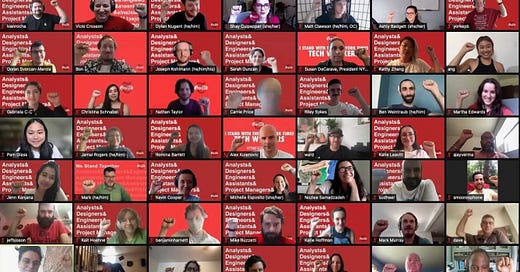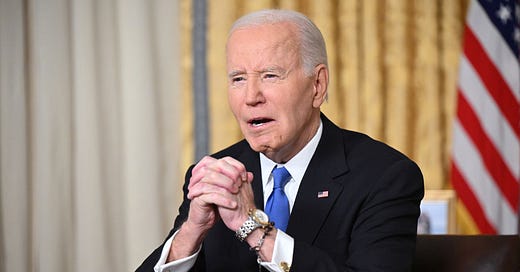
Hundreds of NYT Tech Workers Just Walked Off the Job
'My overwhelming feeling right now is just intense frustration,' one worker said.
Over 300 members of the New York Times Tech Guild walked off the job this afternoon in a planned half-day work stoppage to protest the New York Times Company's aggressive union-busting.
The stoppage was a specific protest against three unfair labor practices, or ULP's, that the News Guild contends New York Times bosses management engaged in while trying to delay, distract or outright bust their tech workers' fledgling union. A representative for the News Guild, which represents the NYT Tech Guild, confirmed that three specific ULPs are currently under investigation by the National Labor Relations Board.
The work stoppage is the culmination of months of frustration for the Times' massive tech workforce, which maintains and builds all of the papers' digital products, from its website to its various apps. Times management, despite the paper's nominally pro-union editorial stance and long history of dealing with unionized journalists (the News Guild has represented many Times staffers for decades) has resisted the Tech Guild's union with the full playbook of standard corporate anti-union activities.
"My overwhelming feeling right now is just intense frustration," Angela Guo, a senior software engineer for the Times, told Discourse Blog. "It feels like the goalposts keep shifting."
It's pretty easy to see where that feeling comes from. Back in May, NYT CEO Meredith Levein offered a downright insulting rationale for refusing to recognize the Tech Guild, claiming that since its members were not journalists, their situation was different from their unionized editorial colleagues. Since then, according to the News Guild, Times management has committed three specific "unfair labor practices," including barring employees who manage interns from showing pro-union support; polling workers on union support, and, in one case, saying in a meeting that workers would get more from management if they stopped their organizing campaign. (The News Guild reported all of this to the NLRB.)
"As frustrating as their insistence to commit these unfair labor practices has been, it’s been incredible to see the solidarity our unit has created," Guo said. "Within a day, to get 300 people to commit to direct action really publicly shows management that despite their best efforts we won’t be divided, that we’re going to stick together."
One of the current pressure points is even blunter: Times management is trying to hack down the proposed bargaining unit. According to Guo, management is contesting that only engineers should be in the Tech Guild's unit, deliberately excluding over 200 analysts, designers, assistants, and product or project managers. The latter two roles often serve as team leads, which management is trying to say makes them supervisors and therefore ineligible for Guild representation, despite the fact that they have no hiring or firing power and do not choose their own teams.
"To exclude hundreds of workers at this stage in the process feels like it’s in really bad faith, it’s contrary to the messaging we’ve received thus far," Guo said, adding that the union refuses to leave those workers behind.
If the Times lawyers and the News Guild can't come to an agreement on the scope of the bargaining unit in the next week or so, the matter will go to an NLRB hearing where both sides will present their case. That hearing might not happen until August 20, and it could take as long as four months for a ruling to come down. While all of this is dragged out, management can continue to hold captive audience meetings, disseminate anti-union propaganda, and chip away at the Tech Guild's support (which currently comprises a supermajority of the proposed unit). All of this is, in other words, is just stalling. It's worth noting that, according to the union, Times' management has contracted Mike Lebowich from Proskauer Rose, whose firm also represented Hearst Corporation in its battle with the union there. That fight was marked by extremely similar instances of union-busting and Unfair Labor Practice allegations. (Hearst failed, and the union won).
The walkout today is meant to show management that if they want to drag their feet, their workers are going to call them on it. At noon, members of the unit stopped working and logged on to a huge, hundreds-strong Zoom call, that Guo said was "electric," especially after words of support from other bargaining units at the Times.
"We aren't happy to be in this position," she said, "but we're so grateful for the cross-unit support, and it's incredible to see the bravery and solidary demonstrated today."
Update, 4:54 p.m. 8/11/21:
New York Times spokesperson Danielle Rhoades Ha responded with the following statement:
The Times’s lawyers attempted to start a discussion with the Guild’s counsel about what an appropriate bargaining unit could look like based on the National Labor Relations Board’s legal framework and our understanding of how our product development teams work. This is part of the typical process that the parties work through in an organizing election. Instead of working with us to reach agreement on a bargaining unit that is appropriate within the scope of the National Labor Relations Act, the Guild issued a public statement.
Because a tech-focused unit of this size and scope is unprecedented, there are several questions and critical issues to address in ensuring there is a proper group for bargaining. We should all welcome a thorough and rigorous NLRB process, which is designed to do just that.
It’s disappointing that the union is more focused on attention-seeking tactics than in having constructive dialogue with the company over the critical issue of who is eligible for the proposed bargaining unit. We continue to support a free and fair election process and remain committed to working with the union in good faith to determine the appropriate unit and schedule an election.












